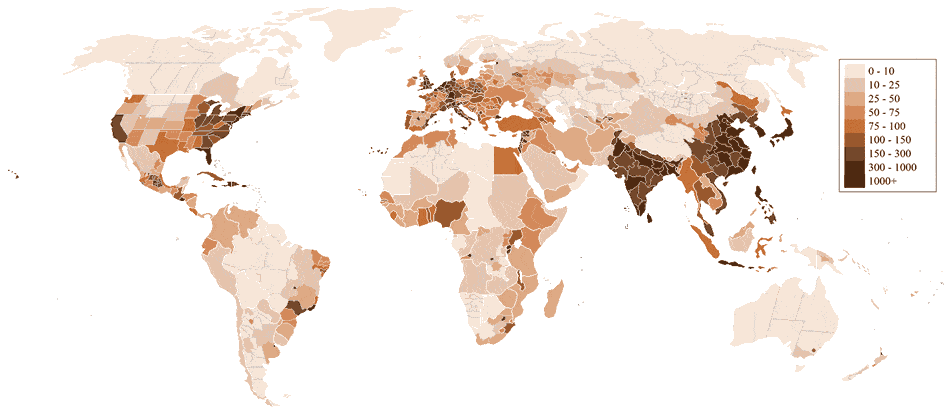Back to: GEOGRAPHY SS2
Welcome to class!
In today’s class, we will be talking about world population. Enjoy the class!
World Population

Population is defined as the number of people living in an area at a particular time.
In terms of countries, China is the most populous country, followed by India, the United States, Indonesia etc. In Africa, Nigeria is the most populous country with an approximate population of over 160million people.
POPULATION CONCEPTS
- OVERPOPULATION: Over-population exists when the given population of a country is considered too large for the available resources for people to enjoy the highest possible standard of living.
- UNDER POPULATION: This is the type of population that is less than the available resources of a country. This means that given the existing technology of such a country; her population is considered too small to fully utilize the available resources.
- OPTIMUM POPULATION: This is the best type of population concept because the number of people is adequately enough to fully maximize the available resources of the country to attain the highest possible standard of living.
- POPULATION DENSITY: This is defined as the number of persons per unit area of land or square kilometre of land.
Mathematically,
Population density = Total Population
. Land Area
FACTORS OF POPULATION GROWTH
Factors responsible for world population growth can be classified broadly into physical and human factors.
Physical Factors:
- Climate: Favorable climate of Europe, USA and China attract high population while the harsh climate of polar and desert regions do not attract population.
- Availability of good portable water for human and agricultural purposes e.g. the USA, India, Java (Indonesia) etc.
- Relief e.g. Lowlands and river valleys like the Nile delta, Indus, and Ganges delta (India) attract high population while high mountains and rugged hills like the Rockies, Andes etc. do not attract population.
- Soil: Fertile soil tends to attract population.
- Presence of mineral resources e.g. Coal, Petroleum, iron ore.
Human Factors:
- Agriculture e.g. Java, China and India practise intensive agriculture hence have a high population.
- Religious beliefs: e.g. The Islamic religion believes in polygamy and early marriages. These encourage the high population in areas where they are practised.
- Industry e.g. Industrial regions like Pittsburg in USA, Ruhr in Germany tend to attract high population.
- Immigration: The movement of people into countries like USA, Canada and some European countries due to opportunities of employment tend to increase the population in these areas.
- Good Transportation Network
- Improved Social Facilities like pipe-borne water, electricity etc. and improved medical care attract high population.
PATTERN OF WORLD POPULATION DISTRIBUTION
World population is not evenly distributed, some areas are densely or moderately
Populated while others are sparsely populated.
The very densely populated parts of the world:
These include:
- Industrial North: Countries here include Great Britain, France, Germany, Denmark, Belgium etc. These areas are highly industrialized due to the presence of coal and iron.
- Industrial North-Eastern USA: This is the great industrial belt of the United States and Canada stretching from the share of the great lakes through Pittsburg to New York which is very rich in coal and Iron ore.
- Agricultural Monsoon Asia: This includes the populous countries like China, India, Japan, Pakistan, Indonesia (Particularly, Java) etc. This area has fertile soil, warm climate and abundant rainfall which promote agriculture.
The moderately populated parts of the world:
These areas include the cool-temperate forest of Europe, Canada and Asia, agricultural USA, Mediterranean Europe, Africa, most parts of South East Asia etc.
The very sparsely populated parts of the world:
These include:
- The cold polar lands of Arctic and Antarctica (very cold areas).
- The Canadian and Eurasian tundra and Greenland (also very cold).
- The high mountains of Himalayas, Rockies and parts of Andes due to rugged topography and cold weather.
- The hot deserts of the world like the Kalahari, Atacama and Sahara deserts (due to hot weather and lack of rainfall).
- The dense tropical rain forest like the Amazon basin (South America), Congo basin (Zaire).
PROBLEMS (DISADVANTAGES) OF HIGH POPULATION DENSITIES
The following problems are associated with high population growth in the USA, Java, India, Japan etc.
- Pressure on natural resources such as Land, water and forest.
- Increase in crime rate.
- Insufficient food.
- Unemployment and underemployment.
- Inadequate housing.
- Traffic Congestion.
- Environmental pollution.
- Pressure on social amenities like pipe-borne water, electricity etc.
- Inadequate health services.
- Development of slums and ghettos.
SOLUTIONS TO WORLD POPULATION PROBLEMS
The following are some of the ways world population problems can be solved:
- Family Planning measures to control the high birth rate especially in developing countries.
- Discouraging early marriages.
- Monogamy and other measures that cut down high birth rate should be encouraged.
- Provision of gainful employment for women: This is to occupy them with gainful ventures rather than continuous breeding of children.
- Sex education should be taught consistently in schools and mass media to enlighten people.
- Encouragement of emigration.
- Stiffening immigration laws.
GENERAL EVALUATION
- Mention three areas in the world where the population is very high.
- Give any two physical factors and two human factors that are responsible for the high population in the world.
- Mention the advantages of high population.
- What are the disadvantages of a high population?
- State the disadvantages of low population.
In our next class, we will be talking about Settlement. We hope you enjoyed the class.
Should you have any further question, feel free to ask in the comment section below and trust us to respond as soon as possible.

You’re doing well. Kudos👍👍👍👍👍
This is very very helpful, thankyou.